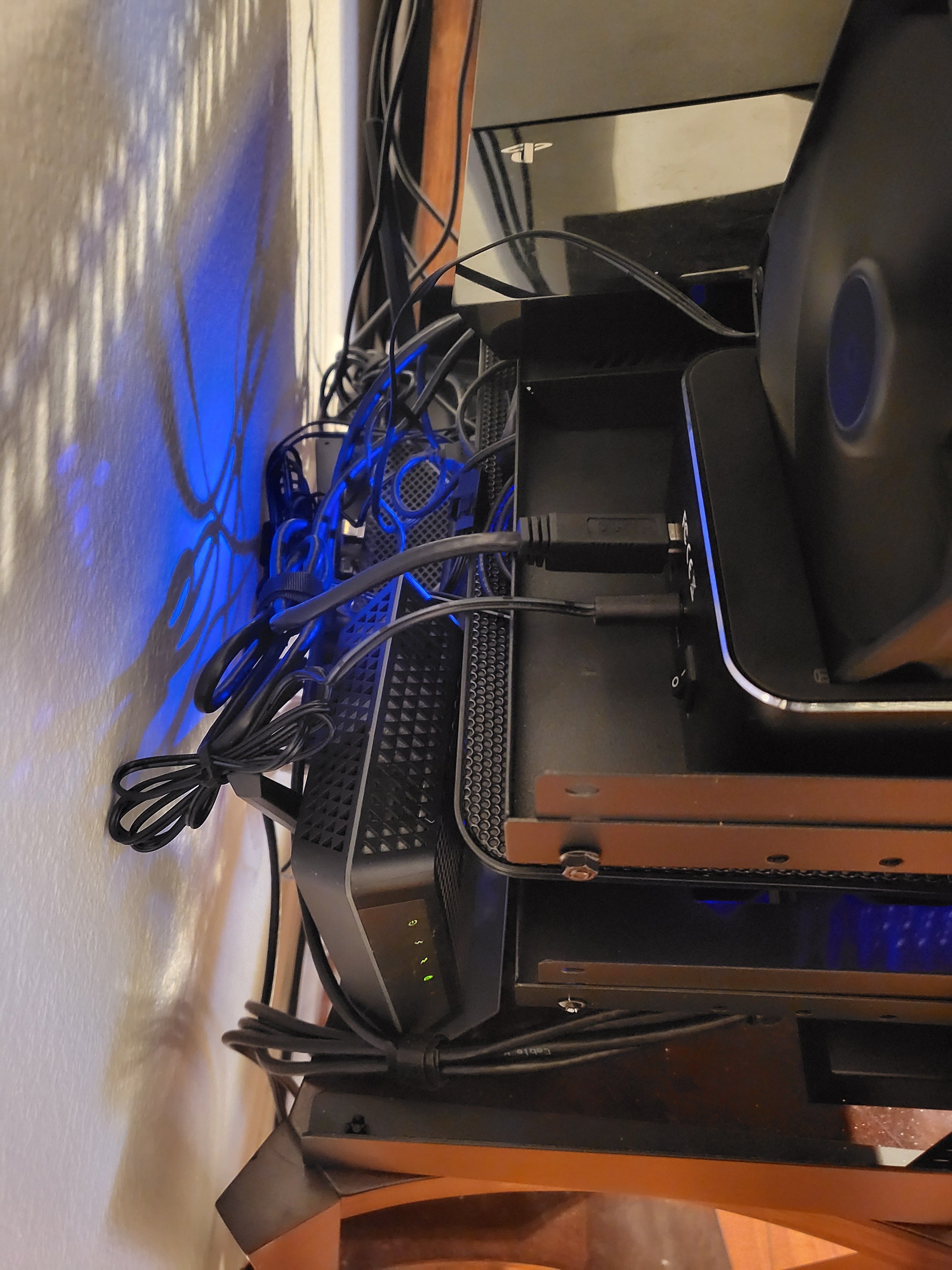
Only use jellyfin. Have a list of things want to update… but it works for now.
Yes that is a laptop usb cooler used as supplemental placebo cooling. Also a pc fan I have propped up against the hard drive feeding into the pi.
Can’t recall last time used the ps4 or switch. But they’re there
lmao mine looks simple af compared with most people here.
Behold my server :

Hardware:
-
Rasberry pi 5 8GB
-
1TB raid between old drives ( one from PC the other a just a regular external WD hard drive ).
Services
- Wireguard VPN/wg-easy
- AudioBookShelf
- Freshrss
- Vaultwarden
- Navidrome
- Calibre Web
- Actual Budget
- Trilium notes
Everything in containers, if you want to know more check this blogpost.
-
What do all you guys use these setups for?
My tech stack:
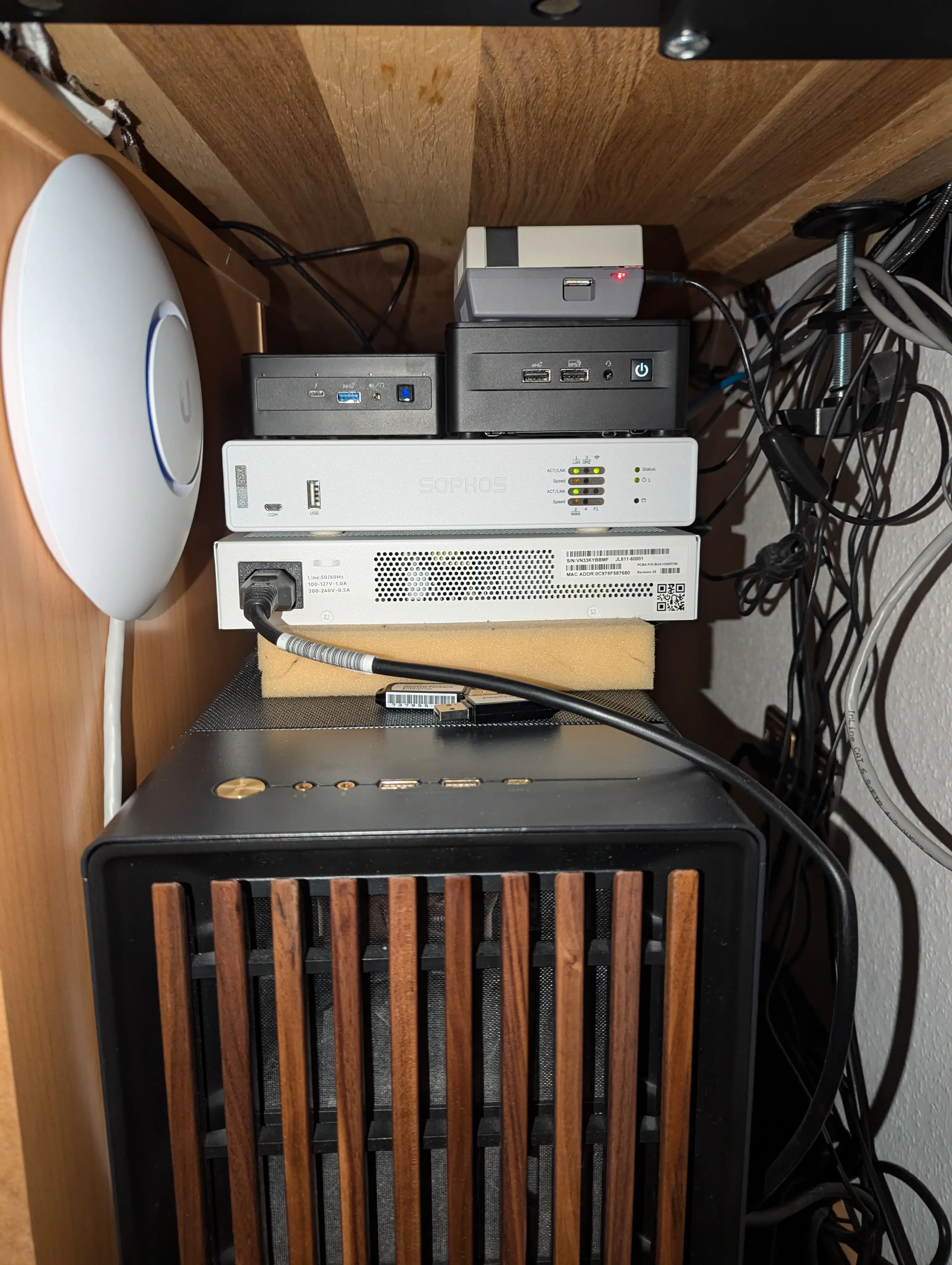
And my storage NAS:
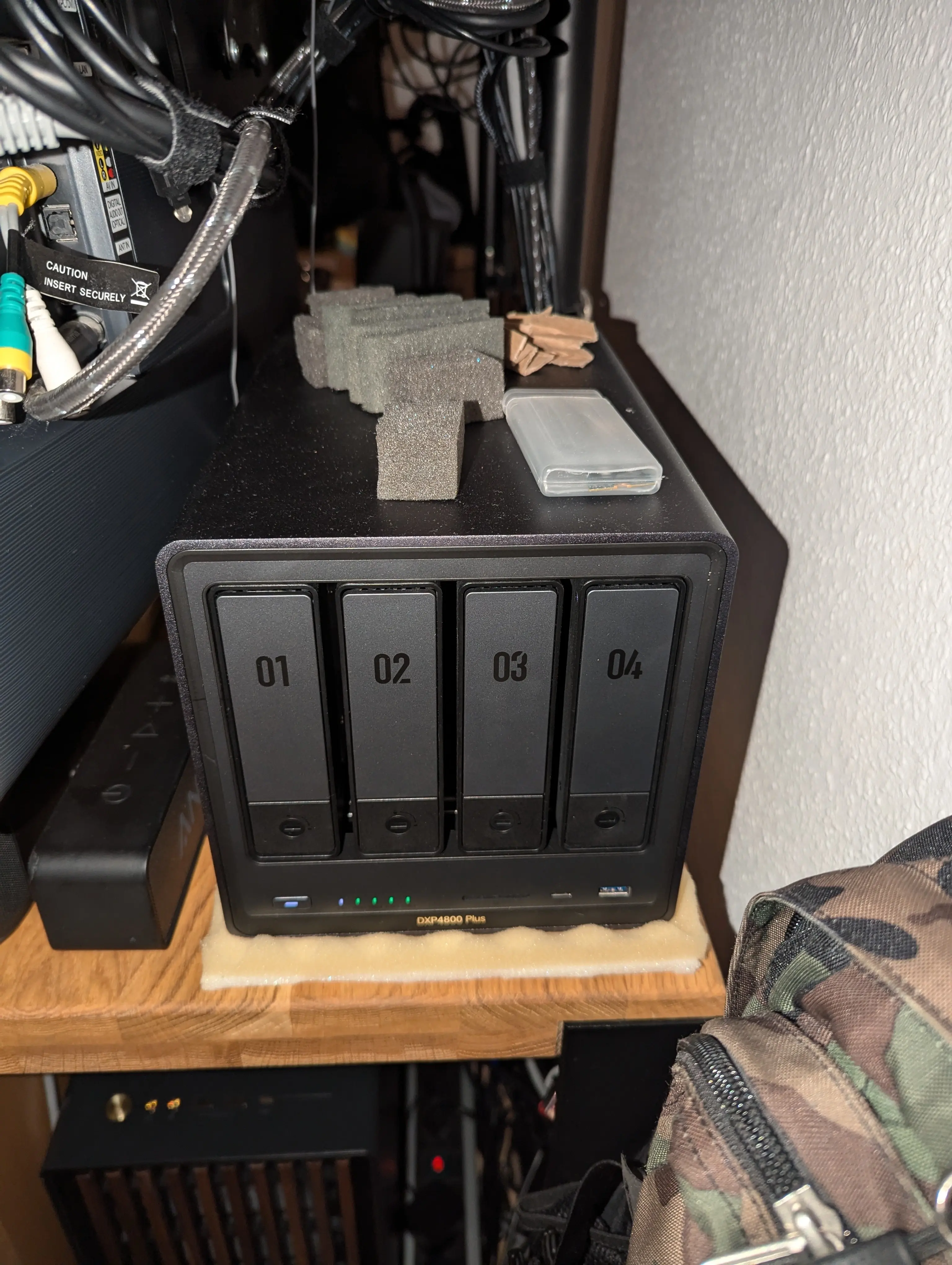
Bottom NUC: General compute
Top NUC: Proxmox with homeassistant, windows server and debian
Raspberry Pi4 inside N64 case: PiHole
Access Point: Unifi Pro
PC for gaming: R7 7800X3D + Nvidia 3070 inside Fractal North
NAS: Ugreen 4800+ with 4x 15TB drives for a total of RaidZ2 30TB usable storage. Used as NFS storage for proxmox.How it started: 2 8TB external HDDs connected to my bottom NUC.
Primary applications:
*arr Suite, Jellyfin, several minor apps.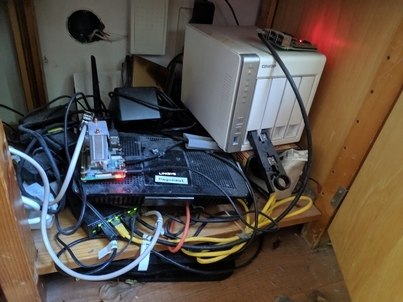
This is how I started in a tiny room. I am not proud, but maybe good to show between all the shiny thongs here.
Used it for Minecraft server for a week then never used it again. Don’t know anything it would be good for that my computer can’t already do better tbh
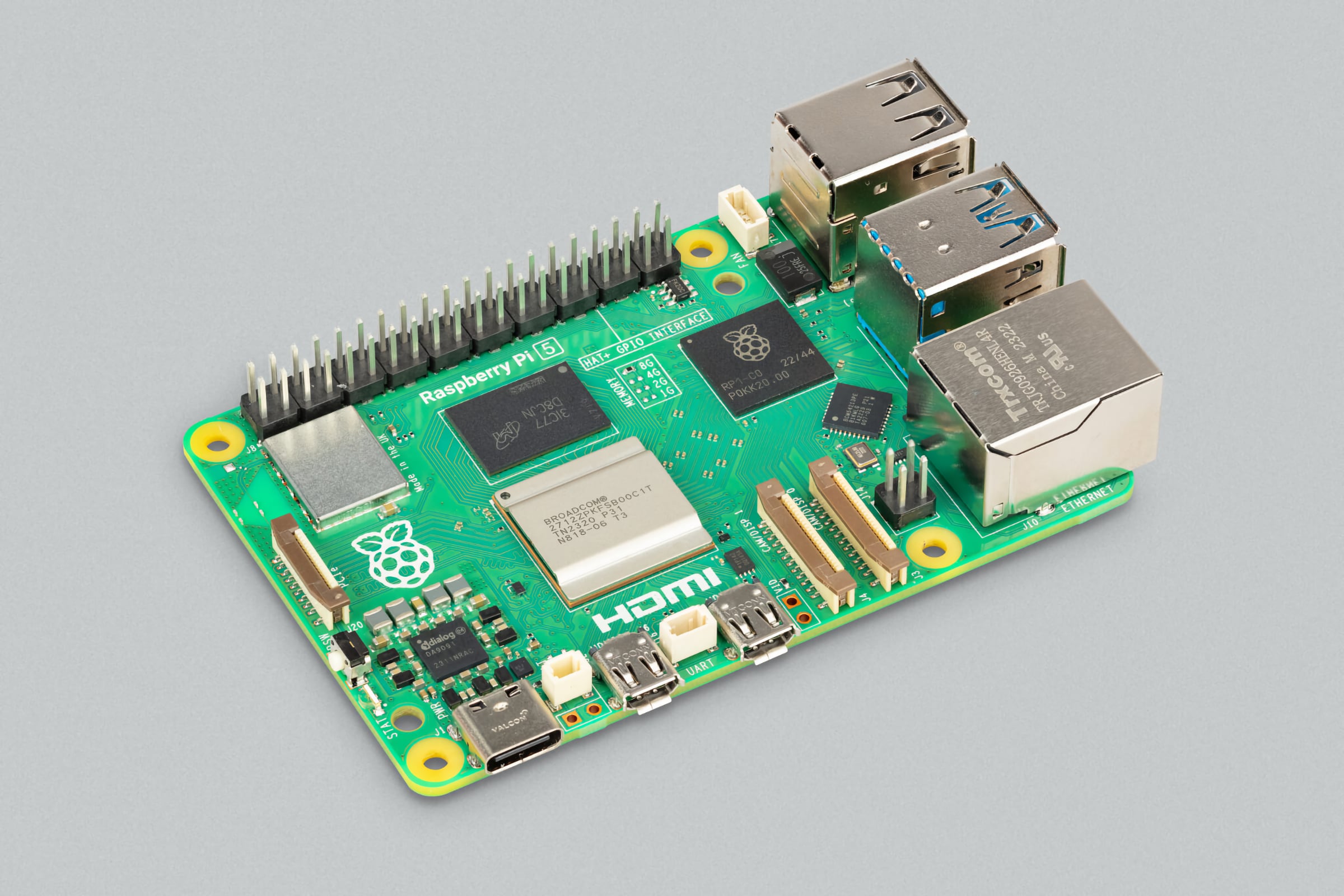
My dusty Intel NUC 10:
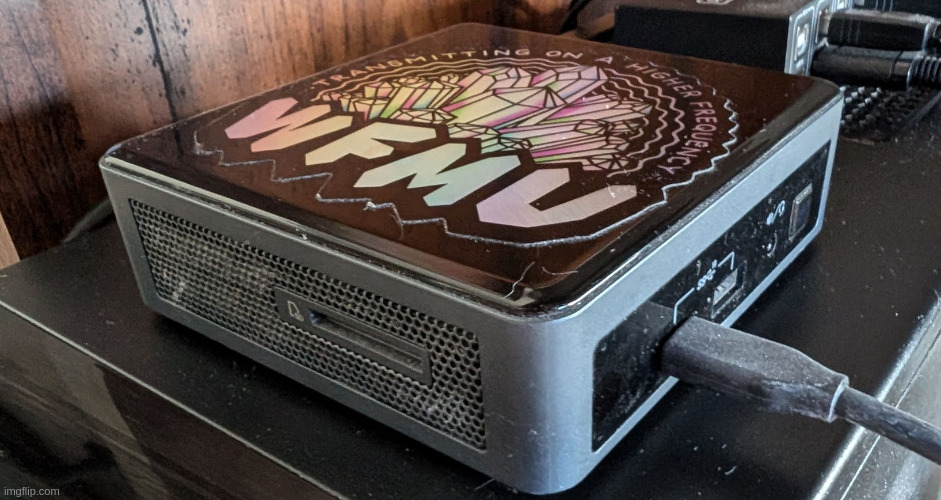
With a 2TB USB drive plugged in on the right there.
Runs all these services via Docker like a champ: AudioBookshelf, Dockge, File Browser, Forgejo, FreshRSS, Immich, Jellyfin, LemmySchedule, Memos, Navidrome, Paperless NGX, Pihole, Planka, SideQuests, Syncthing, Wallos
literally one these with loads of RAM and a wifi card, so i can fit all the shenanigans in one box
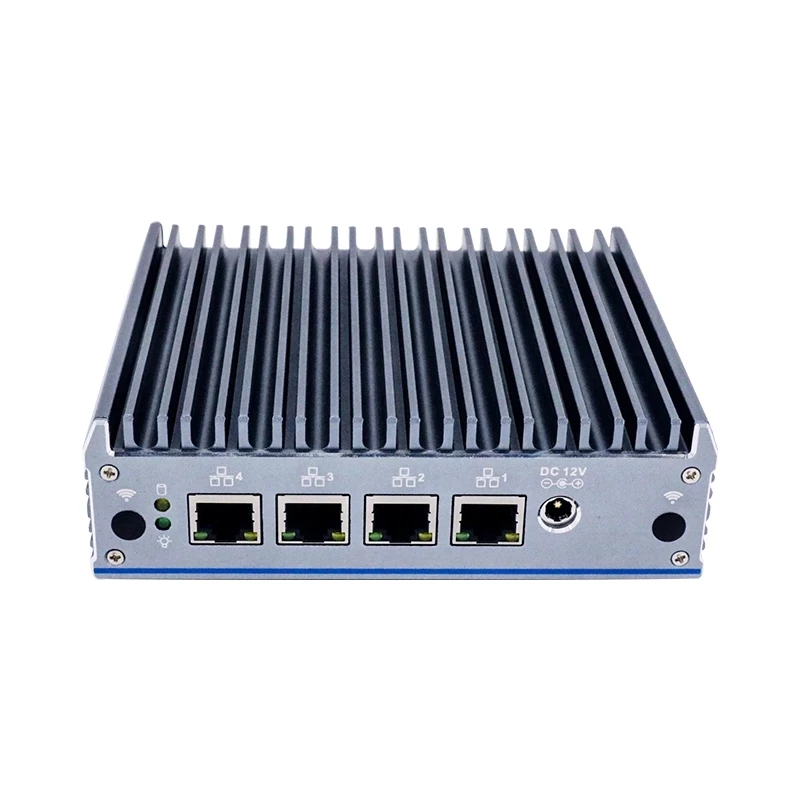
What is the Wi-Fi card for? What software are you using?
I may need this now. Would you are the brand? A recommendation?
Old setup:
Lenovo ThinkCentre M900 that I bought refurbished for ~€130
- i5-6500T (Passmark score 4792)
- 8GB RAM
- 512GB SATA SSD + 128GB SATA SSD (completely used for swap)
- Buffalo DriveStation™ HD-WLU3 that I bought second hand for €10
- 2 × 2TB SATA HDD’s in RAID 1
- ~20W
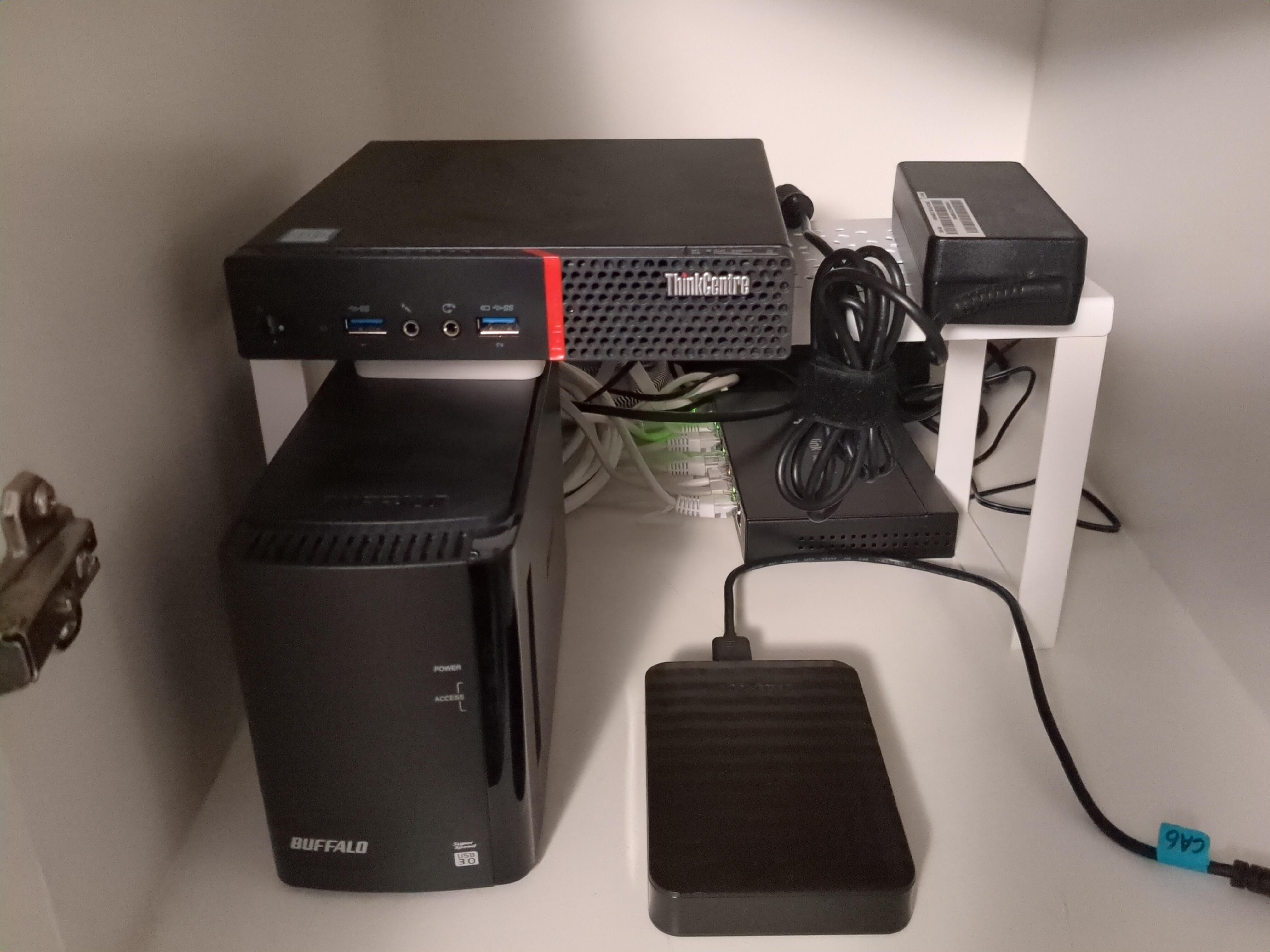
New setup:
Custom build
- ASUS Prime N100I-D D4 (Passmark score 5501) (~€100)
- 16GB RAM - Crucial CT16G4SFRA32A (€28)
- 512GB SATA SSD
- 4 × 4TB SATA HDD’s in RAID 5 using mdadm (€160)
- M.2 NVME to SATA 6x (ASM1116 for C-states) (€17)
- 17.8W
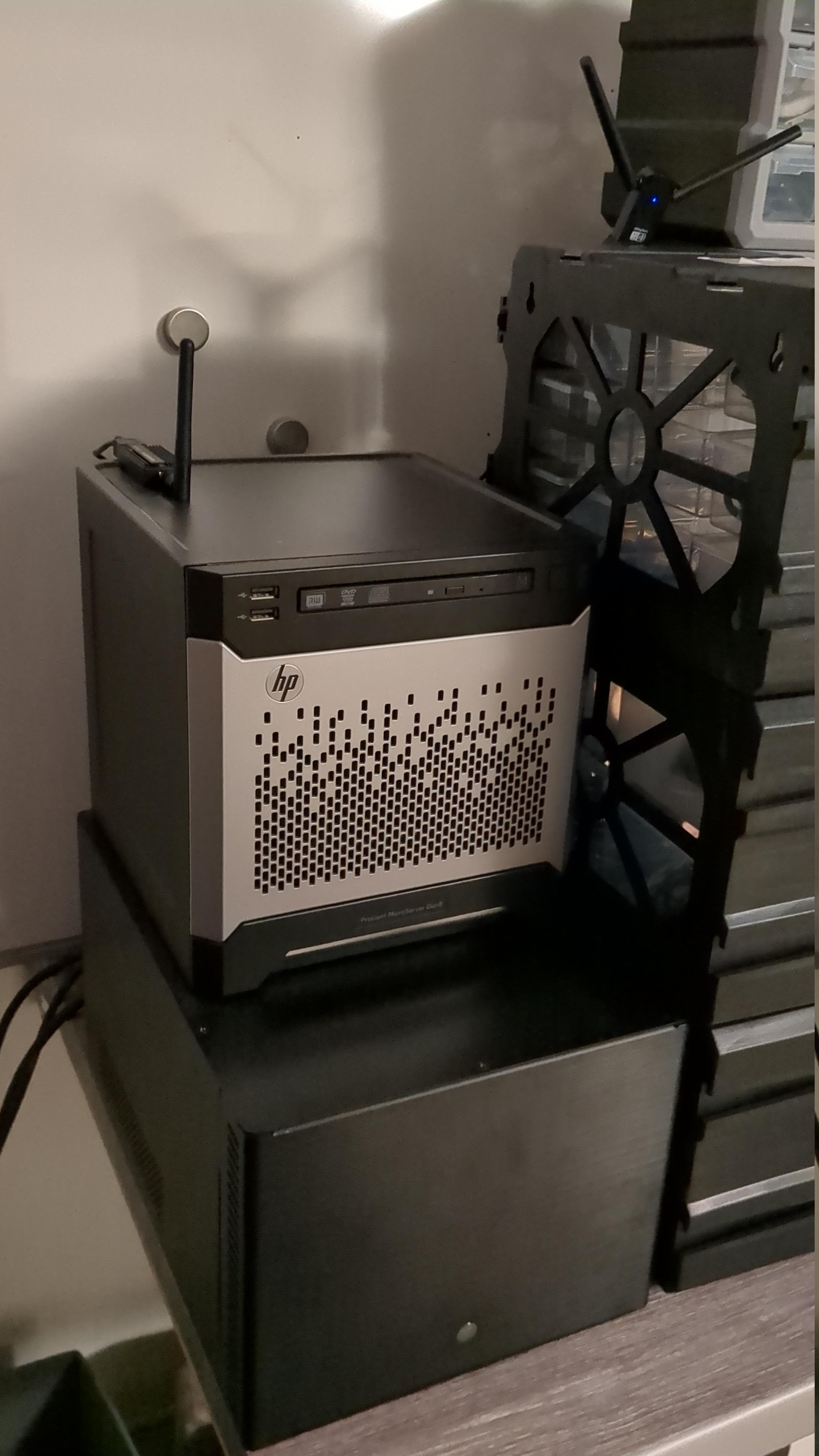
(Not the Proliant Microserver Gen8 on top, the device below)
The antennas are from a Sonoff Zigbee dongle and a bluetooth dongle for Home Assistant.
I’ve mostly focused on power usage, price, and reliability since I’m a student and don’t want to spend a month’s worth of income on a “home lab”.
It’s running the following:
- Forgejo
- Grafana
- Home Assistant
- Jellyfin
- Kopia
- Nginx-proxy-manager
- Paperless NGX
- Photoprism
- Syncthing
- TimescaleDB
- Uptime-kuma
- Vaultwarden: As backup
- Watch Your LAN
- Arr stack (currently disabled)
- Homebox: Still up for testing, like it has been for the past couple months. It’s a great concept but the execution ain’t great (does anyone happen to know an alternative?)
It’s using about 10% CPU and is running below 40°.
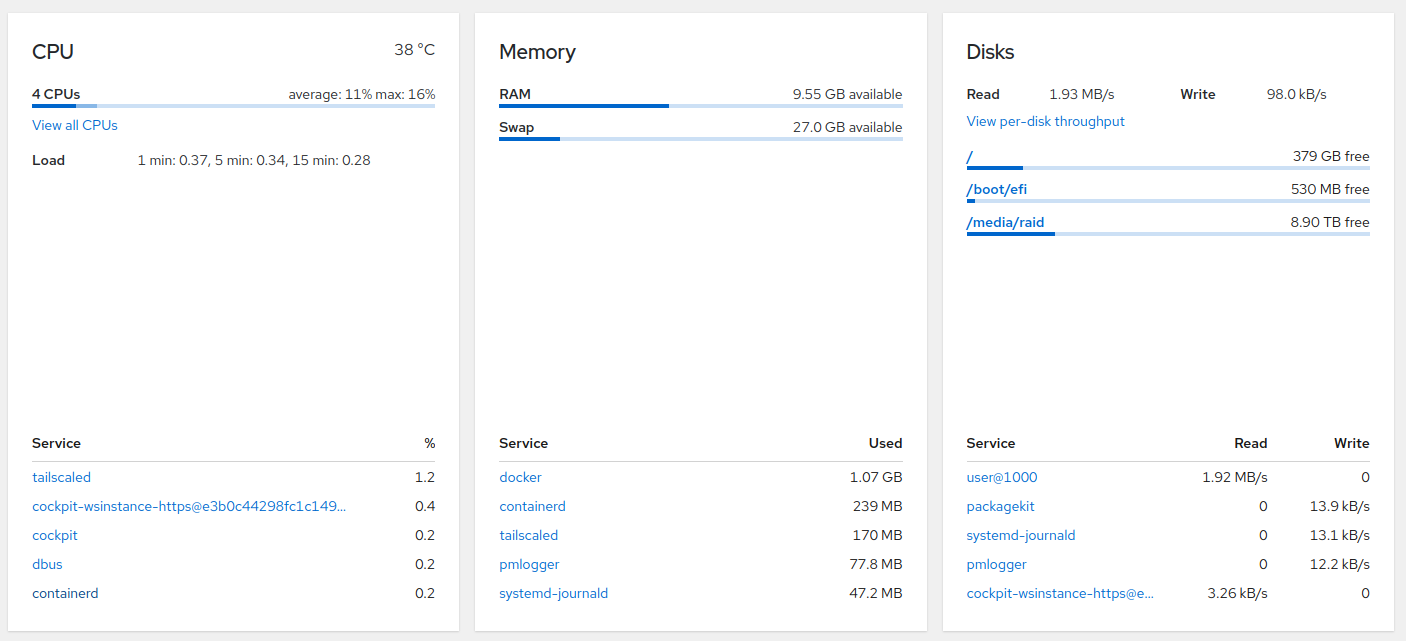
I have three of those Proliant Microserver Gen8’s. Two of them are part of my Proxmox cluster, and the other one is waiting for me to install Proxmox on it.
I’m currently just using it for occasional backups (it has 12TB storage) since the power consumption (60W idle when in the BIOS) is just unreasonable.
You people are such nerds. Wish I could self-host too.
You can get a setup going on whatever personal computer until you throw ~$150 on a mini PC.
The basement network and storage/server racks.

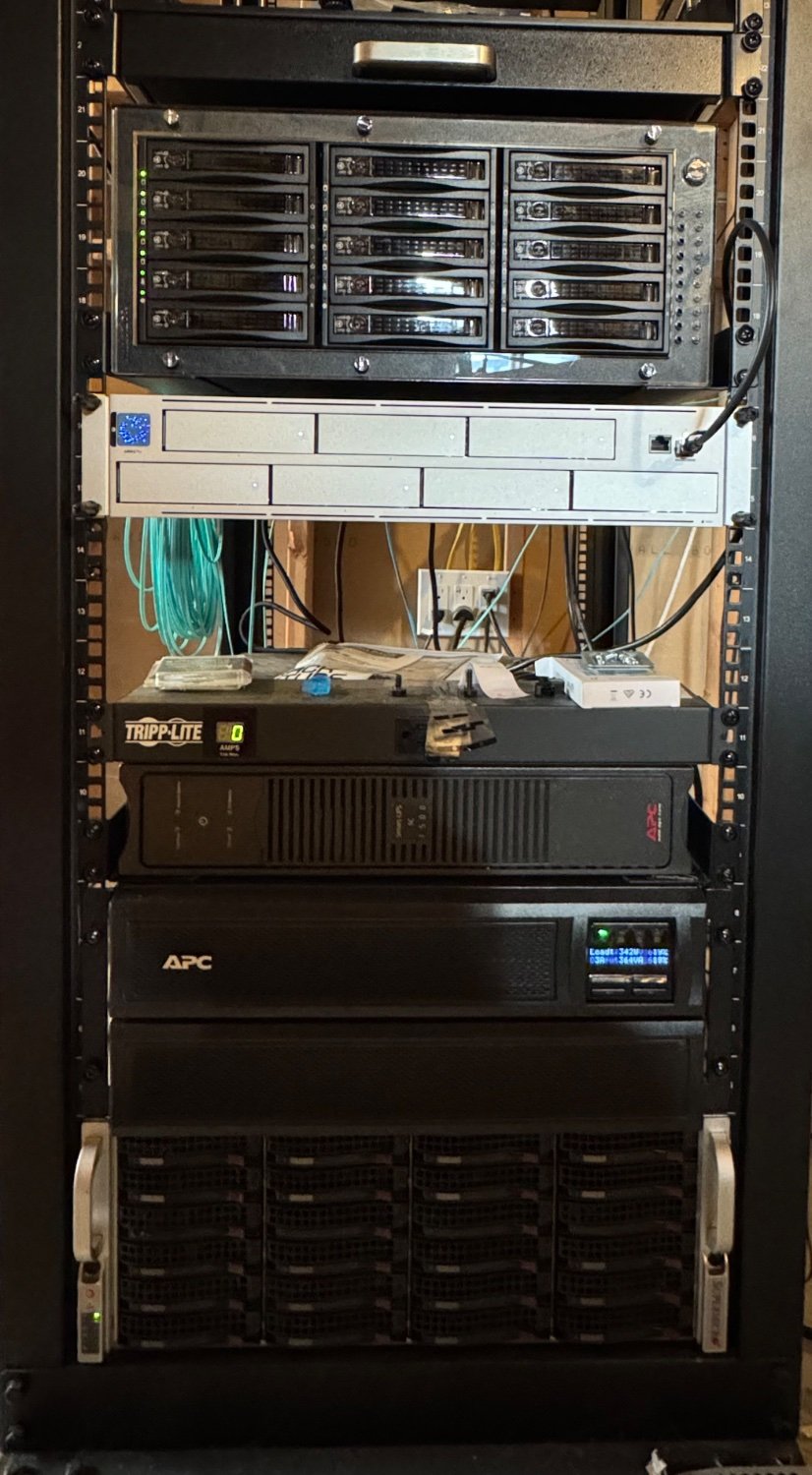
Heavy lifting boxes…


Is that a Unifi PDU/UPS? Didn’t even know they made these.
Also, you need to peel the stickers of the screens.
That is what it is. My older CyberPower unit is down below. Was just easier to manage it all from one place. Need to repurpose that or sell it off…
The screens work fine with the stickers on. Never saw the point in peeling them off.
Only real reason IMO is dust can collect on the seam and it’s annoying to clean without taking the peel off anyway.
IDK why people get weird about it.
was going through some old pictures and decided I’d post a retro setup. pretty sure I took this picture with my android g1…so 2008ish?
here is a pic of one of my first selfhost setups. I began selfhosting for music and have never stopped. this iteration was stuffed behind a bar that was built in to the basement at my old house
the old fashioned was custom built and was running some flavor of windows server. the one on the floor was the first Linux server I had run to do something useful…torrents and subsonic IIRC. I pieced that server together with random parts, mostly donated from old family PCs. two UPS units were on the bottom rack of that metro shelf to battery back the servers and the tomato router out of frame.
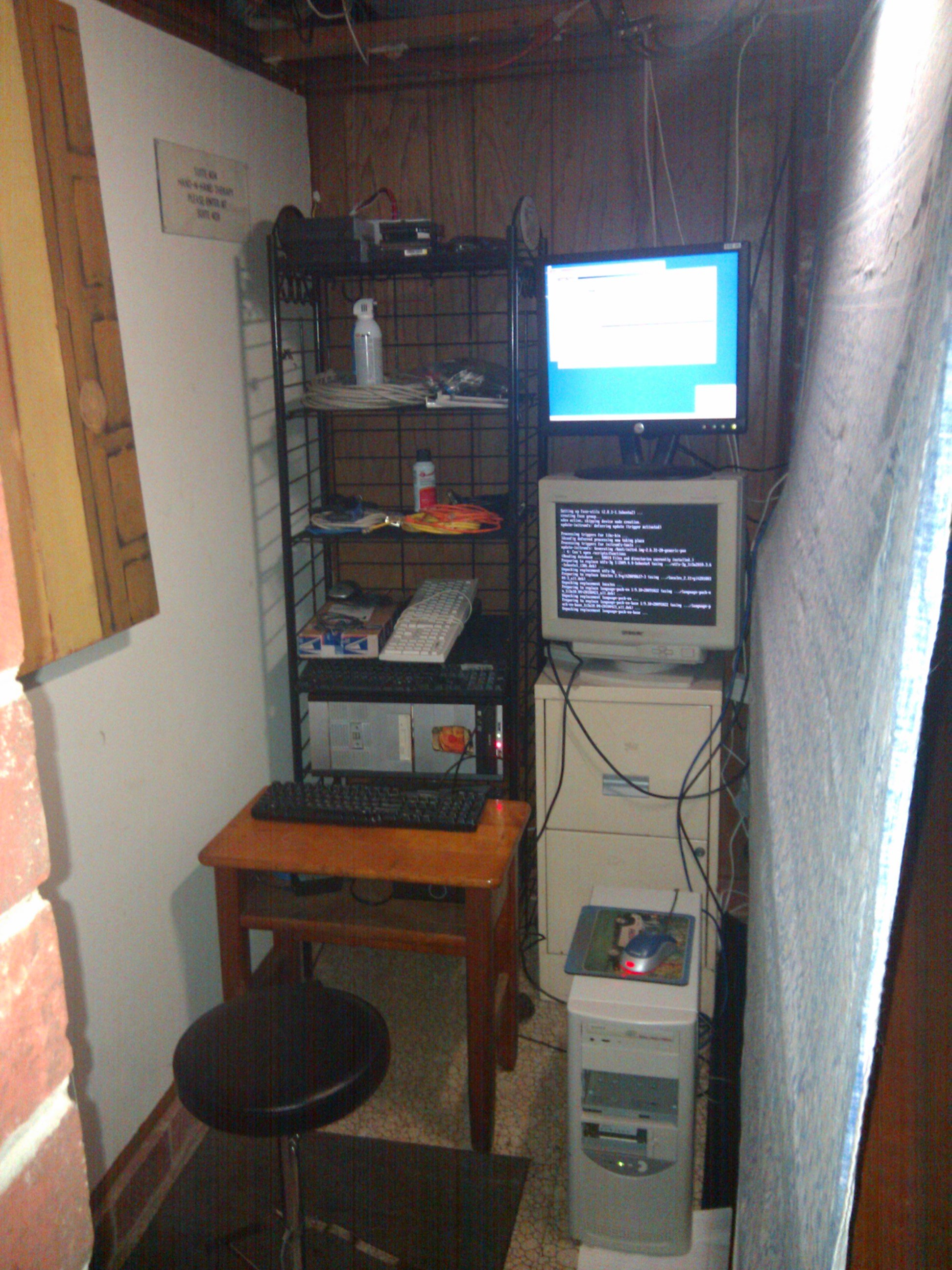
What I took from this post is that every living room / home theater setup needs a server rack instead of a HiFi rack. Dudnt matter what you thrown in it, it looks badass.
 An old HP laptop with Debian hosting Klipper and Home Assistant. Waiting for an OTG cable so I could replace the laptop with a phone for less power and heat
An old HP laptop with Debian hosting Klipper and Home Assistant. Waiting for an OTG cable so I could replace the laptop with a phone for less power and heatUsing phones with a continuous power supply might do nasty things to the battery.
Source: I finally figured out how to open a glass back phone with no tools.
Heat, then suction?
On a related note, I solved the battery issue with my wall mounted Fire tablet (for an HA dashboard) by connecting the power supply to a smart plug and setting up an automation to only give it the juice for about 3 hours per day, spread throughout the day
It still amazes me that the smartest phones aren’t yet smart enough to have direct power supply.
Like my 40 year old AM radio.
I’ve done similar with an old Android tablet. Installed Fully Kiosk Browser to display the dashboard AND read the battery level - above 75%, switch off power…
But… automations only trigger when going past the threshold once, so if there’s a random issue where HA doesn’t see the battery drop below 10%, (had that happen a few times in the past), then I also have multiple triggers for 5% and 2%… to turn the power back on again 😉
Yeah, the tablet runs Fully Kiosk and I tried the same thing with the battery percentage thing and ran into the same issue, so I just simplified and made the automation time-based.
The tablet also likes to freeze a few times a day, so I also created an automation that toggles the smart plug power whenever HA loses connection to the tablet for more than 5 seconds, then toggles back to the original state at the start of the automation, which corrects the problem. Until the next time. But hey! It was only $60, so it’s fine.
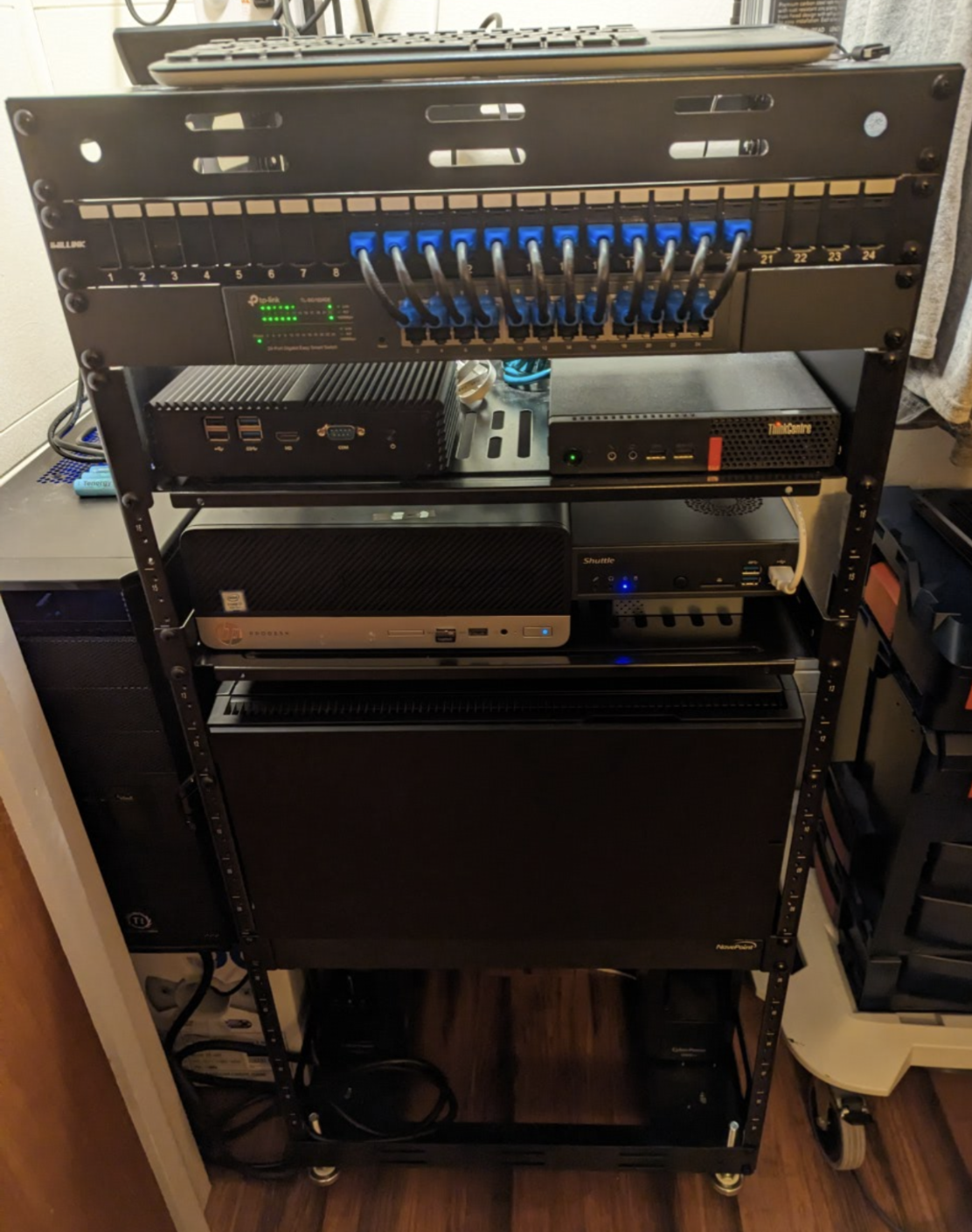 From top to bottom:
From top to bottom:- Patch panel (with artisinal, handmade cables)
- TP-Link managed switch Shelf 1:
- PFSense 4 port firewall
- Lenovo m910q w/Proxmox (cluster node 1) running 2 VMs for docker hosting: Ubuntu for media stuff (arrs, navidrome, jellyfin, calibre, calibre-web, tubesync, syncthing) and Debian for other stuff (paperless-ngx, vikunja, vscodium, redlib, x-pipe webtop, fasten health, linkwarden, alexandrite), 1 Win 10 VM for the very few times I need to use windows, some Red Hat Academy student and instructor RHEL 9 VMs, and an OPNsense VM for testing Shelf 2:
- HP Elitedesk G5 800 SFF w/Proxmox (cluster node 2) with an Nvidia GT 730 passed through to a Debian VM used primarily as a remote desktop via ThinLinc, but also runs a few docker containers (stirling pdf, willow application server, fileflows)
- Shuttle DH110 w/Proxmox (cluster node 3) with 1 VM running Home Assistant OS with an NVME Coral TPU passed through as well as a zooz 800 long range zwave coordinator (the zigbee coordinator is ethernet and in a different room) and two LXCs with grafana and prometheus courtesy of tteck (RIP) Shelf 3:
- WIP Fractal R5 server to replace the ancient Ubuntu file server to the left (outside the rack, sitting on the box of ethernet cable) that is primarily the home of my media drives (3 12 TB Ironwolf drives) and was my first homelab server. The new box will have a Tesla p4 and RX 580 GTX, i7-8700T and 64GB RAM in addition to the drives from the old server. I’ll be converting the Ubuntu drive from the old server into an image and will use it to create a Proxmox VM on the new server, with the same drives passed through. Bottom:
- 2 Cyberpower CP1000 UPS with upgraded LiFePO4 batteries. The one on the left is only for servers and only exists to give the servers time to shut down cleanly when the power goes out. The one on the right is only for network devices (firewall, switch and the Ruckus R500 out of shot mounted higher in the closet)

Top to bottom:
- Unifi US-16-XG
- OPNsense DEC740
- Unifi Switch 24
- Unifi Switch 16 PoE
- DIY server with an AsrockRack X470D4U mainboard
- DIY DAS in an old server case with 18 3.5" bays
Not in picture: My UPSes, RIPE Atlas probe and an Odroid N2+ running my Home Assistant instance
The server runs Proxmox with a bunch of LXC containers running a Docker Swarm cluster.
There’s too many services running so I’m not listing them all. Let’s just say my phone is not going to be thrilled if it goes down. Also, this post was posted through said server.








